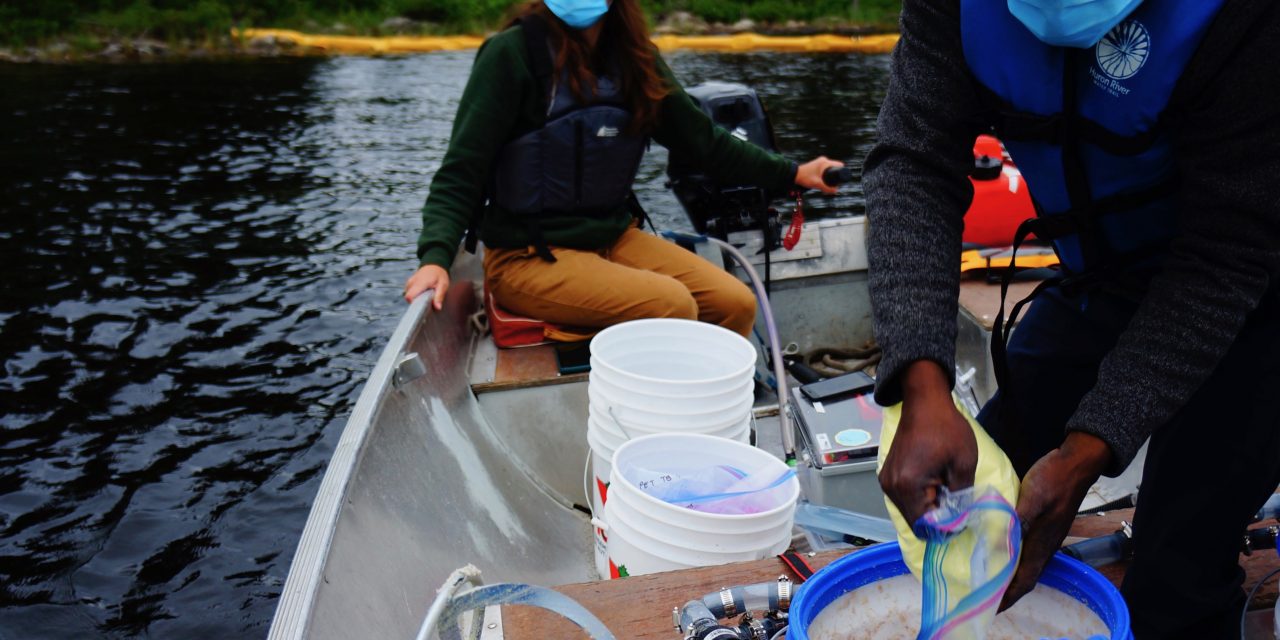Plastic pollution has become a global problem, and not just in landfills. When left to accumulate in the environment, plastics break down into smaller pieces, called microplastics. Their small size and persistence in the environment mean microplastics are everywhere: in the air we breathe, in the food we eat, in the water we drink. Microplastics can have complex impacts on organisms, as they interact both chemically and physically, which can impact everything from the smallest cells to the largest environments. Ocean ecosystems have been a focus of microplastics research for decades, but efforts have not been convincing enough for protection to extend to freshwater. In Canada, the average person creates 125 kilograms of plastic waste per year (around 700 water bottles). As a result of insufficient waste management, water quality surveys across the Great Lakes reported levels of microplastics ranging from 30,000 particles per square kilometre in Lake Superior to 6,700,000 particles per square kilometre in Lake Ontario. Results from surveys were not convincing enough to enforce mitigation. Laboratory studies show negative effects on fish health (changes in feeding and fertility, organ damage, movement of plastics between tissues) and on human health (allergic reactions, cell death, immune system disruption). Results from laboratories were not convincing enough to enforce risk assessment. So, we are taking on the macro problem of microplastics at the freshwater ecosystem scale.
I work on pristine, small boreal lakes set aside for research and whole-lake experiments to understand how human activity affects our freshwater. We have a unique agreement with the Province of Ontario to study, experiment on, and recover 58 lakes and their watersheds in a remote area of Northwestern Ontario, 450 kilometres northwest of Thunder Bay, on Treaty 3 traditional territory. These research lakes are removed from human pressures, including the effects of city life, industry, and agriculture. Specifically, I work with fish on a five-person crew of biologists, technicians, and research assistants at the IISD Experimental Lakes Area (IISD-ELA).
We practice the three Rs of animal welfare: reduction, replacement, and refinement. We capture thousands of small- and large-bodied fish using non-lethal methods and we measure thousands of fish to identify any changes in their growth and condition across baseline, experiment, and recovery phases of whole-lake studies. We develop non-lethal methods and collect samples (gastric lavage, mucus swab, muscle biopsy) from our fish to minimize our impacts on our small lakes with small fish populations. We tag, we clip, we mark, and we return the fish to the lake in the same morning or afternoon. Then we capture them again to inform our non-lethal mark-recapture population estimates. We do this alongside long-term monitoring of fish in our unmanipulated reference lakes, to rule out environmental effects. There are seasonal checks to ensure reduction in the number of samples, replacement of more sensitive species, and refinement of our methods.
While we study the fish, researchers intentionally add microplastics representative of common products—plastic water bottles (polyethylene terephthalate), plastic cutlery and cups (polystyrene), and plastic bags (polyethylene)—to a lake. Every two weeks, a carefully measured 76 kilograms of microplastics is dispersed, which is equivalent in both weight and density to a 167-pound human and is based on the (environmentally relevant) amount documented in Toronto Harbour. Graduate students round out our fish efforts with studies of amphibians, birds, invertebrates, plankton; IISD-ELA crews sample the lake and analyze the full suite of chemical and physical water quality parameters. Students and scientists alike examine detritus, guts, sediments, and tissues for recovered microplastics, every year, to determine how microplastics travel and break down and impact freshwater ecosystems, to acquire the data needed to inform policy, and to incite permanent change. This study is set to span 10-plus years—will this be convincing enough!?
We need to practice the three Rs of waste management: reduce, reuse, and recycle. While we wait on the whole-lake results to prompt large-scale plastic policy, immediate small-scale efforts can be made. For such a widespread issue, most microplastics in freshwater originate from local sources (compared to global sources of ocean microplastics). So, any local initiative to eliminate single-use plastics, prevent and divert microplastics in runoff, and promote individual decisions to reduce, reuse, and recycle (including slow fashion and any part of the slow movement) will decrease the prevalence and persistence of microplastics in our own backyard—rivers and lakes.
Editorial and photo by Lauren Hayhurst















